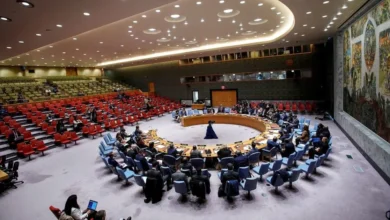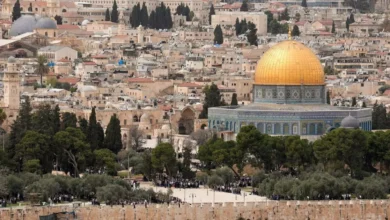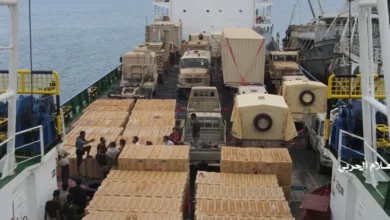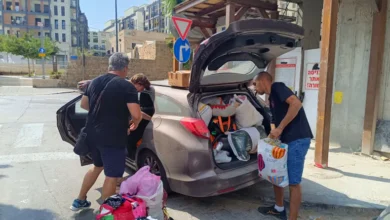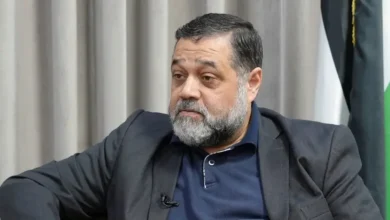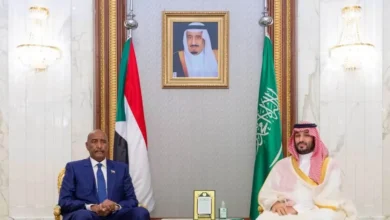Saudi to Dubai in an hour? Hyperloop chief sees GCC transport link as ‘possible’

Hyperloop could connect major cities between Saudi Arabia and the UAE in as quick as one hour, the CEO of one of the world’s biggest transport systems said.
Hyperloop is a next-generation technology that aims to connect cities in record time through transport pods zooming through tubes up to 1,000 kilometers per hour.
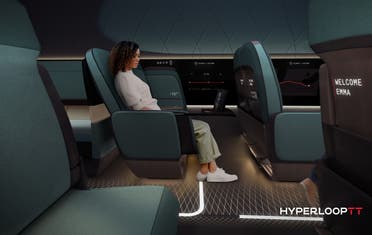
Andres de Leon, chief executive of Hyperloop Transportation Technologies (Hyper-loopTT), revealed that “conversations have been had” with countries in the GCC – including the UAE and Saudi Arabia – to bring the mass transport system to the region. Plans to bring a hyperloop prototype to Northern Italy – between Venice and Padua – through a joint venture between the Italian government and private investors reignited interest in the project.
That system – which aims to be the world’s first working passenger system and will propel people between cities in pods more than twice as fast as high-speed rail net-works and far more sustainably – aims to be up and running between 2028 and 2030, de Leon said.
He said that the GCC could potentially “hop on that first wave” and develop “in parallel” with the Italy project. While Hyperloop technology is still in the early stages globally, it is seen as a potential transportation system for the Gulf region’s sprawling urban areas. The vacuum tube environment allows ultra-high speeds that are impossible with traditional rail due to air resistance. Hyperloop networks are also designed to be electric and solar-powered, providing sustainable transportation.
“We have reestablished some of our old conversations. We have started the conversations in the UAE, we have started the conversations in Saudi,” de Leon said. “It is very recent. We don’t have a big development (to announce) right now, but our vision is clear. If you think of the Middle East – and the real opportunity it has to be-come a major tourism hub – with everything they are doing in Saudi, with everything they are doing in Dubai, it makes sense to create something in the Gulf region that is fully connected.”
“If you think you can leave Dubai and arrive in Riyadh city center in one hour – that changes drastically the way interactions are going in the Gulf.”
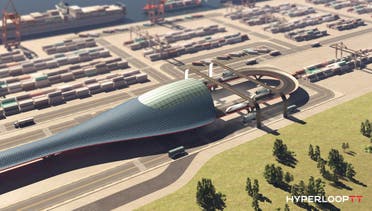
Previous talks in Saudi around Hyperloop
Talks have previously taken place in the Kingdom around the Hyperloop project.
In 2020, Saudi Arabia announced it was conducting a first-of-its-kind national hyperloop study to evaluate how a hyperloop carrying both passengers and cargo could spark economic benefits, create jobs and develop high-tech skills.
Two years prior, in an interview with Al Arabiya, Saudi Arabia’s Minister of Energy, Industry and Mineral Resources, Khalid al-Falih, spoke about Saudi Arabia’s interest in partnering in the Hyperloop project, if proven of value. He said at the time that Saudi Crown Prince Mohammed bin Salman wanted the Kingdom as a partner in the Hyperloop experience, and pointed out that the Hyperloop technology has proved successful on a smaller scale but needs to reduce cost and be checked for longer dis-tances.
Hype and skepticism
Hyperloop technology has previously been met with both hype and skepticism. Critics have pointed out the immense technical challenges required to build safe, functional Hyperloop networks while creating low-pressure tubes hundreds of miles long, developing viable pod technology, and creating feasible safety measures, which are also daunting tasks. The high costs and infrastructure requirements also raise questions of financial viability.
There has been “volatility” around the idea of Hyperloop over the last decade since the mass transportation system was first mooted, agreed de Leon, bringing caution among governments, bankers and investors.
“People were starting to think that the Hyperloop was not going to happen – that it was kind of a dream,” he said. “We were starting to have some level of skepticism about the technology.”
In December, the industry also suffered a setback as Hyperloop One, the startup be-hind the ambitious high-speed transport system proposed for the UAE and beyond, declared its cessation of development and decision
to sell off its assets.
But interested parties are back at the table, said de Leon.
“The situation has changed completely; everyone was starting to see that it is possible from a technological point of view but also from an economical point of view. But everyone was saying, ‘Who is going to be the first one?’”
Italy project sparks renewed interest
The $800 million Italy project has led to a resurgence in global interest, says de Leon. “Nobody is going to be investing unless you have some project that is really working and we have restarted multiple conversations around the world with gov-ernments and investors now.”
“And the Italy project opened a completely different angle. Now, you don’t need to take all the risk. You can take the risk together with Italy. You are de-risking the project drastically.”
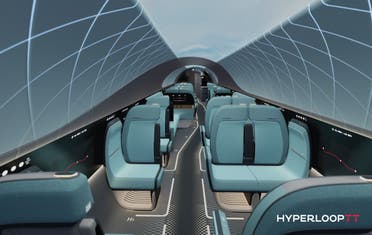
He said he would like to see a GCC Hyperloop project happen in “parallel” with the Italy project.
“There are two options here (but global investors),” he said. “Wait and see – wait until 2029 and see if it is working. But then maybe it is too late. Not too late for the transportation but you are going to lose the opportunity to revitalize the industry. Or, option two. Try and be in the first wave. And you know, the Middle East likes to be innovators. They like to be in the first wave. So, hopefully we can convince governments in the region that being in the first wave is a much, much more attractive opportunity for them.”
He said that Europe’s transportation network can demonstrate the potential success of Hyperloop.
“If you take a look at Europe, then one of the biggest advantages of Europe is the connection – you can go with high-speed rail to almost all the capitals of Europe. The problem with high-speed rail is that it is not quick enough. If you want to go to Rome to Paris, then you take the plane because nobody wants to spend six hours on a train.”
“Hyperloop would solve that problem.”
Sustainable benefits
He said while high-speed rail networks – which have the ability to transport passengers at speeds of 300 kilometers – are “great,” they have their setbacks.
“First, when you try and connect passengers to cities more than 500 kilometers away, people don’t take the train. So, the demand falls drastically. Secondly, when you want to go faster with high-speed rails then you have exponential consumption of energy.”
In contrast, Hyperloop pods glide easily through low-pressure tubes, using very little energy, which means lower greenhouse gas emissions. The pods are also propelled by linear electric motors, making Hyperloop fully electric.
“Everyone is talking about sustainability – especially after COP28 – everyone is talking about CO2 emissions. Our energy consumption is very low, and we generate more energy than we consume based on renewable energy. We are also working on looking at all the materials in the value chain that could drastically reduce the CO2 emissions during construction.”
“Plus, Hyperloop has the potential to travel at speeds of 1,200 kilometers an hour – although the average will be 800. Fast is important– as it will change the way people think of long-distance travel. If you can be someone – like in Dubai from Riyadh in just one hour – you can be in the environment you need to be in just for one day.”
Aside from high-speed connectivity, de Leon said Hyperloop looks to bring mass so-cio-economic benefits and give countries like Saudi Arabia and the UAE a chance to diversify away from oil, in line with each country’s plans.
“I think that the socio-economic impact that Hyperloop implementation could have in the region is huge. You can use Hyperloop to create an industry around it. You are going to need factories to manufacture the capsules, you are going to create new jobs, you are going to need centers of excellence, you are going to have to create the infrastructure for the data layer (of the technology). So, there is a lot of opportunities.”
“This is not just a transport opportunity; it’s an economic opportunity.”
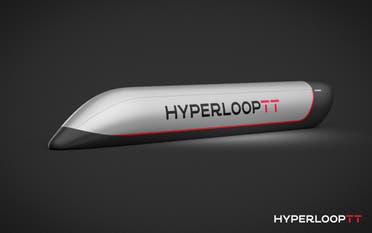
The Italy project is an 800-meter project that will be done in three different phases.
“There is officially the assessment – that is six months – then engineering – that is 18 months – and then finally around two to four years for building, the prototyping, test-ing and certification.”
The idea is to have the first 10 kilometers fully operative and tested, then decide which cities will ultimately be connected, said de Leon.
Phase one began on February 11, with Hyperloop TT having until 2030 to finalize the project.
“But the customer wants to have something up and running by 2028 and also, something to showcase by the 2026 Winter Olympics in Italy. But I will say between 2028 to 2030 we will see passengers on a Hyperloop if
everything goes as expected.”
High costs
The Hyperloop project in Italy will first connect Venice-Mestre and Padua – a 40-kilometer route – at a cost of $800 million – about $20 per kilometer, based on early cost predictions.
With a land route from Dubai to Riyadh being almost 1,000 kilometers, if costs were projected the same, then the project could run into the billions of dollars.
Hyperloop first mooted a decade ago
Entrepreneur Elon Musk first put up the idea of a hyperloop in 2013 as a quicker, safer, and more effective substitute for high-speed rail and flying. Since then, several businesses hopped on to the idea and have
been developing and testing the hyperloop technology.
HyperloopTT was one of the first companies to emerge after Musk detailed his idea for tubes transporting people at airplane-like speeds in capsules underground.
Other companies include Hyperloop One – formerly Virgin Hyperloop – a company that was established in 2014 with the goal of developing and promoting hyperloop technology. Musk’s Hyperloop company, the Boring Company, also proposed an ambitious transportation system in Las Vegas that would transport passengers in electric vehicles at speeds of up to 150 miles per hour.

